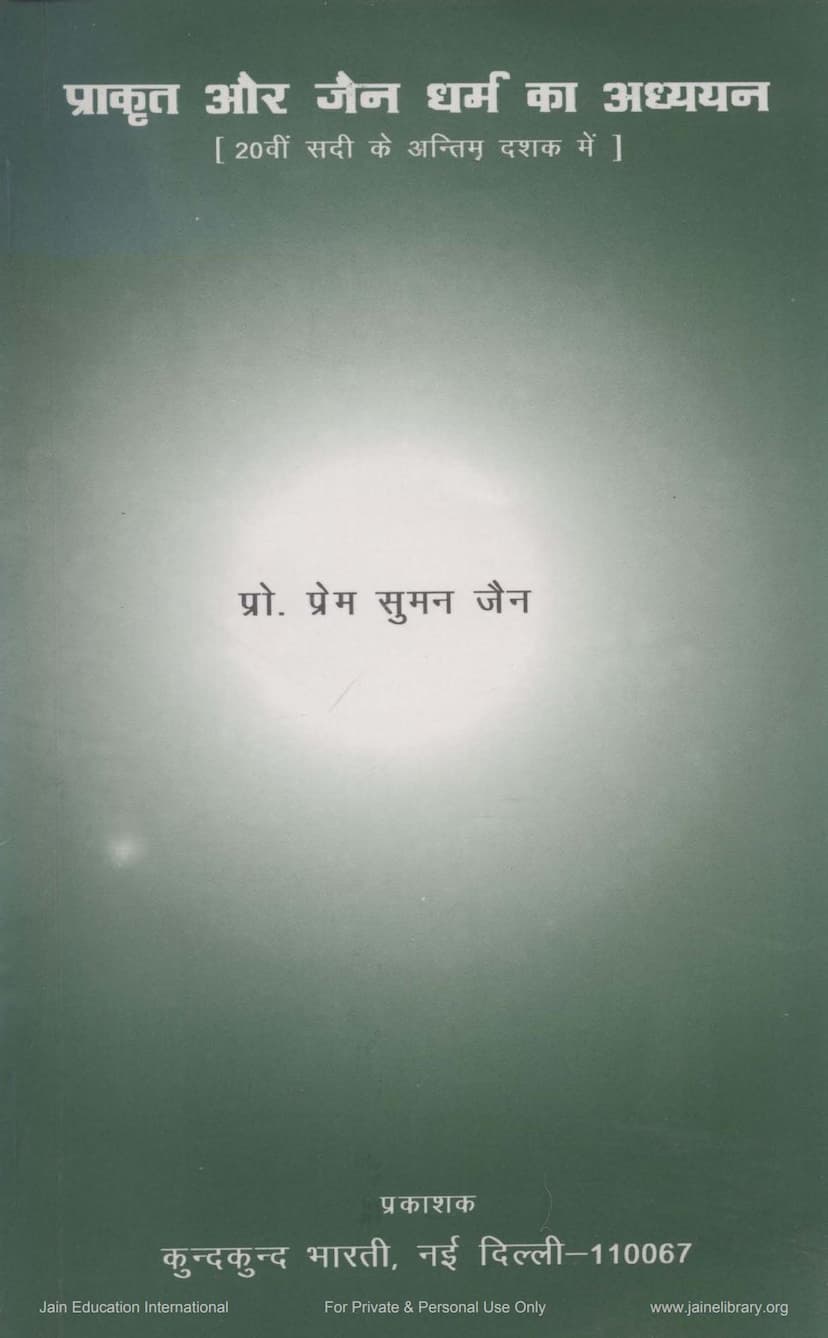Prakrit Aur Jain Dharm Ka Adhyayan
Added to library: September 2, 2025

Summary
Here's a comprehensive summary of "Prakrit aur Jain Dharm ka Adhyayan" (Studies in Prakrit and Jainism) by Prem Suman Jain, based on the provided text:
This book, presented as the presidential address at the 40th session of the All India Oriental Conference in Chennai in May 2000, by Professor Prem Suman Jain, Head of the Department of Jainology and Prakrit at M.L. Sukhadia University, Udaipur, focuses on the studies in Prakrit and Jainism during the last decade of the 20th century (1990-2000).
The author begins by expressing gratitude to the Tamil Nadu region, highlighting its rich history and significant role in the flourishing of Jainism and Prakrit literature, with prominent Jain scholars like Kundkund, Samantabhadra, Pujyapada, Akalanka, and others contributing to its intellectual heritage.
The core of the address is a detailed overview of the research and academic activities related to Prakrit and Jainism in the final decade of the 20th century. Professor Jain acknowledges the significant contributions of various institutions and individuals in advancing the study of these fields.
Key themes and observations from the text include:
-
The Importance of Prakrit:
- Prakrit is presented as the language of the common people, used by influential figures like Lord Mahavir, Emperor Ashoka, and Kharavela for spreading their messages.
- It is deeply intertwined with Jain Agamas and also found in Vedic literature and ancient Indian inscriptions.
- Prakrit served as a primary medium for dramatic arts and was the vernacular language of the masses.
- The evolution from Prakrit to Apabhramsha and then to modern Indian languages is noted.
- Prakrit literature is a rich repository of cultural history, offering insights into trade, arts, crafts, medicine, astrology, geography, metallurgy, and chemistry.
- It possesses significant poetic beauty and has influenced Indian poetics.
-
The State of Prakrit Studies:
- The author laments the lack of comprehensive analysis of the research conducted in Prakrit and Jainism over extended periods, with even recent presidential addresses going unpublished.
- He notes the establishment of Prakrit and Jainology departments and chairs in various universities, along with the commencement of Prakrit teaching in Pali and Sanskrit departments.
- Institutions like the Prakrit Research Institute in Vaishali have contributed to the revival of Prakrit studies.
- A significant number of manuscripts related to Prakrit and Apabhramsha are preserved in libraries, but a large portion remains unedited and unpublished.
- There is a critical shortage of scholars dedicated to the survey, cataloging, and editing of these manuscripts, leading to a slow pace of new publications.
- The author emphasizes the need for more comprehensive Prakrit grammars and comparative dictionaries.
-
Jainism and its Ethical Framework:
- Jainism is described as an ancient Indian religion advocating equanimity, non-violence (ahimsa), self-control (samyama), and austerity (tapas).
- The ethical code of Jainism is not merely about moral duties but is intrinsically linked to its philosophical and spiritual tenets, aiming for self-realization and liberation.
- The concept of the soul's inherent potential and the importance of human effort in achieving spiritual goals are highlighted.
- Ahimsa is presented as the cornerstone of Jain ethics, permeating all other vows and practices.
- Jain ethics promote a balance between individual well-being and societal upliftment, emphasizing compassion, friendship, and non-attachment.
-
Research and Publications:
- The text extensively details various universities, research institutes, and organizations actively involved in Prakrit and Jainological research and publication in India and abroad.
- It lists numerous doctoral dissertations and publications, providing a snapshot of the research landscape.
- Notable institutions like Shri Kundkund Bharti Prakrit Sansthan, Jain Vishva Bharti Institute, Agam Ahimsa-Samata evam Prakrit Sansthan, and others are recognized for their significant contributions.
- The increasing number of research papers and books in various fields of Jain studies, including philosophy, history, literature, art, and comparative studies, is acknowledged.
-
Challenges and Future Directions:
- A major concern raised is the insufficient number of scholars and the slow pace of publication for the vast number of existing manuscripts.
- The need for greater public interest and participation in Prakrit language education is stressed.
- The author suggests a need for better coordination among institutions and scholars to avoid duplication of efforts and to advance the field effectively.
- Recommendations are made for creating comprehensive Prakrit manuscript catalogs, editing and translating texts, compiling Prakrit dictionaries and grammars, and establishing Prakrit language labs.
- The importance of promoting Prakrit studies at university levels through adequate faculty appointments and scholarships is emphasized.
- The author calls for a renewed focus on the linguistic and cultural aspects of Prakrit, recognizing its foundational role in the development of Indian languages.
-
Global Contributions:
- The book also touches upon the contributions of Western scholars to Jainology, acknowledging their diligent and unbiased research.
- It highlights the growing interest and academic activities related to Jainism in countries like Germany, Belgium, the USA, Canada, the UK, and Japan.
- The text mentions various international conferences, seminars, and publications that have furthered the study of Jainism globally.
In essence, Professor Prem Suman Jain's presidential address serves as a comprehensive review of the progress and challenges in the study of Prakrit and Jainism in the late 20th century. It underscores the enduring significance of Prakrit as a cultural and linguistic heritage and the vital importance of continuing research and dissemination of Jain philosophy and ethics for the benefit of humanity. The text also implicitly calls for greater institutional support and scholarly dedication to preserve and promote this rich intellectual tradition.